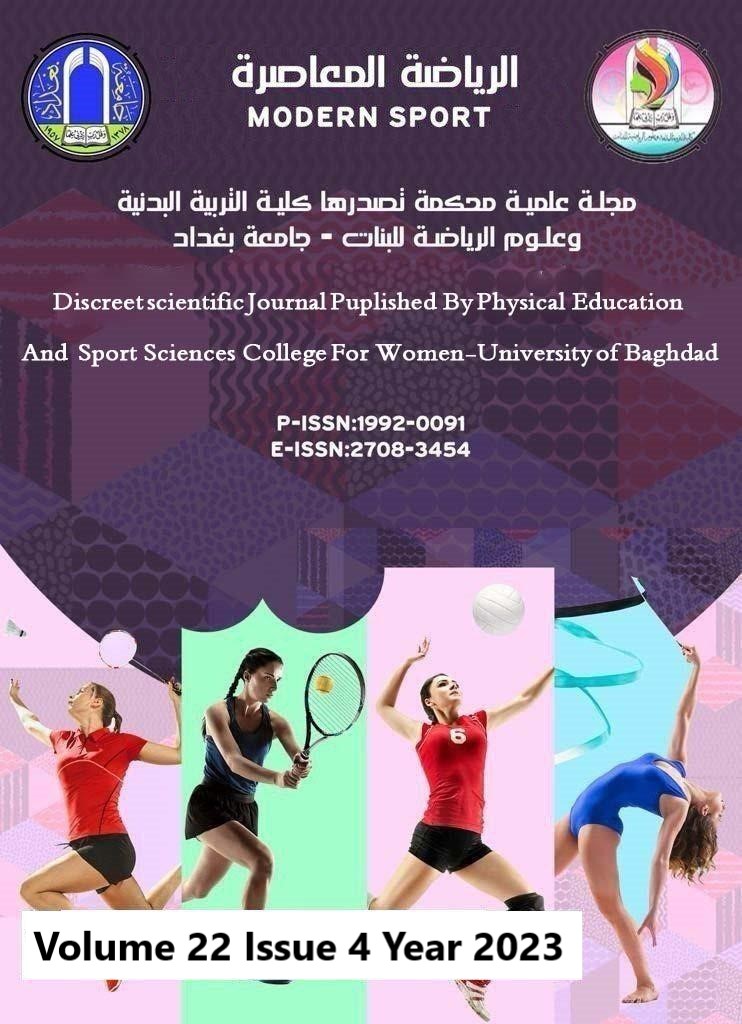علاقة اختبار التوازن الديناميكي (Y) مع قوة الاطراف السفلية لطلاب كلية علوم الرياضة في الجامعة العربية الامريكية
DOI:
https://doi.org/10.54702/ms.v22i4.1203الكلمات المفتاحية:
قوة الأطراف السفلية، اختبار التوازن Yالملخص
هدفت هذه الدراسة إلى توضيح العلاقة بين مسافة اختبار التوازن (YBT) وقوة الأطراف السفلية لدى طلبة كلية علوم الرياضة في الجامعة العربية الأمريكية، تطوع للمشاركة في البحث أربعون (40) طالباً جامعياً بأعمار (19.80 ± 1.26) سنة، مسجلين في الفصل الثاني من العام الدراسي 2022-2023 من قسم علوم الرياضة، خضع المشاركون لاختبار MMT (اختبار العضلات اليدوي) لتقييم الحد الأقصى لقوة العضلات في الأطراف السفلية، بما في ذلك ثني الورك، وتمديد الورك، وإبعاد الورك، وتقريب الورك، والدوران الداخلي للورك، والدوران الخارجي للورك، وثني الركبة، وتمديد الركبة، وعطف ظهري الكاحل، وانثناء الكاحل الأخمصي). بالإضافة إلى ذلك، قاموا بإجراء تقييمات اختبار التوازن (YBT) في الاتجاهات الأمامية والخلفية الإنسية والخلفية الوحشية. تم استخدام اختبار (ت) لعينة مستقلة لمقارنة المتوسطات بين مجموعتين، وتحديداً الذكور والإناث، لتقييم الفروق. تم استخدام معامل ارتباط بيرسون لتحديد العلاقات الخطية بين مسافات YBT وقوة الأطراف السفلية. ارتبط امتداد الورك بشكل إيجابي مع مسافات YBT في المسافات الأمامية والخلفية والخلفية الجانبية، وعلاوة على ذلك، ارتبطت ثني الورك واختطاف الورك بشكل إيجابي مع مسافات YBT الأمامية والخلفية. أظهرت قوة ثني الركبة وتمديد الركبة وجود علاقة إيجابية مع المسافة الأمامية YBT. في الختام، كان هناك ارتباط ضعيف بين قوة الأطراف السفلية (ثني الورك، وتمديد الورك، وإبعاد الورك، وانثناء الركبة، وتمديد الركبة) والتحكم الديناميكي في الوضعية، كما تم قياسه بواسطة YBT، وهذا ما يحقق احد اهداف التنمية المستدامة للامم المتحدة في العراق (الصحة الجيدة).
المراجع
Alqaraan, A. A., Alsharksi, R. M., Taha, N. S. Q., & al-Awamleh, A. (2018). BMI and Static, Dynamic Balance Abilities among Undergraduate Sports Students. American International Journal of Contemporary Research, 8(3). P:44 https://doi.org/10.30845/aijcr.v8n3p5
Anderson, C. N. (2016). Iliopsoas: pathology, diagnosis, and treatment. Clinics in sports medicine, 35(3), 419-433. https://doi.org/10.1016/j.csm.2016.02.009
Butler, R. J., Bullock, G., Arnold, T., Plisky, P., & Queen, R. (2016). Competition-level differences on the lower quarter Y-balance test in baseball players. Journal of athletic training, 51(12), 997-1002. https://doi.org/10.4085/1062-6050-51.12.09
Butler, R. J., Lehr, M. E., Fink, M. L., Kiesel, K. B., & Plisky, P. J. (2013). Dynamic balance performance and noncontact lower extremity injury in college football players: an initial study. Sports Health, 5(5), 417-422. https://doi.org/10.1177/1941738113498703
Coughlan, G. F., Fullam, K., Delahunt, E., Gissane, C., & Caulfield, B. M. (2012). A comparison between performance on selected directions of the star excursion balance test and the Y balance test. Journal of athletic training, 47(4), 366-371. https://doi.org/10.4085/1062-6050-47.4.03
Gribble, P. A., Hertel, J., & Plisky, P. (2012). Using the Star Excursion Balance Test to assess dynamic postural-control deficits and outcomes in lower extremity injury: a literature and systematic review. Journal of athletic training, 47(3), 339-357. https://doi.org/10.4085/1062-6050-47.3.08
Lee, D. K., Kim, G. M., Ha, S. M., & Oh, J. S. (2014). Correlation of the Y-balance test with lower-limb strength of adult women. Journal of physical therapy science, 26(5), 641-643. https://doi.org/10.1589/jpts.26.641
M. Ibtihal Ryadh Umran, & Intisar Kadhum Abdul-kareem. (2021). Motor capacity and its relationship with some indicators Albaiukinmetekih and performance of the wheel of human skill. Modern Sport, 20(2), 0099. https://doi.org/10.54702/msj.2021.20.2.0099.
McCreary, E. K., & Provance, P. G. (1993). Muscles, testing and function: with posture and pain. Williams & Wilkins, p. 179-90.
Mendonça, L. M., Bittencourt, N. F. N., & Santos, M. B. (2016). Interpretando os resultados de testes funcionais na prática clínica. Sociedade Nacional de Fisioterapia Esportiva; Macedo CSG, Reis FA, organizadores. PROFISIO Programa de Atualização em Fisioterapia Esportiva e traumato-ortopédica: ciclo, 6, 128–131.
Neves, L. F., Souza, C. Q. D., Stoffel, M., & Picasso, C. L. M. (2017). The Y balance test–how and why to do it. Int Phys Med Rehab J, 2(4), 99-100.
Norris, B., & Trudelle-Jackson, E. (2011). Hip and thigh-muscle activation during the star excursion balance test. Journal of Sport Rehabilitation, 20(4), 428-441. https://doi.org/10.1123/jsr.20.4.428
Ohkoshi, Y., Yasuda, K., Kaneda, K., Wada, T., & Yamanaka, M. (1991). Biomechanical analysis of rehabilitation in the standing position. The American journal of sports medicine, 19(6), 605-611. https://doi.org/10.1177/036354659101900609
Plisky, P. J., Gorman, P. P., Butler, R. J., Kiesel, K. B., Underwood, F. B., & Elkins, B. (2009). The reliability of an instrumented device for measuring components of the star excursion balance test. North American journal of sports physical therapy: NAJSPT, 4(2), 92 – 99.
Plisky, P. J., Rauh, M. J., Kaminski, T. W., & Underwood, F. B. (2006). Star Excursion Balance Test as a predictor of lower extremity injury in high school basketball players. Journal of orthopaedic & sports physical therapy, 36(12), 911-919.
Tajwar Y, Anamul H, Sanjay K & Tabassum S, (2018); Relationship between Body Mass Index and Dynamic Balance in Elderly Population: A correlational analysis, Journal of Emerging Technologies and Innovative Research (JETIR), Volume 5, Issue 10, p.p. 301 – 304.
Wilson, B. R., Robertson, K. E., Burnham, J. M., Yonz, M. C., Ireland, M. L., & Noehren, B. (2018). The relationship between hip strength and the Y balance test. Journal of sport rehabilitation, 27(5), 445-450.
التنزيلات
منشور
إصدار
القسم
الرخصة
الحقوق الفكرية (c) 2023 الرياضة المعاصرة

هذا العمل مرخص بموجب Creative Commons Attribution 4.0 International License.















